Papers by Reinhard Bernbeck
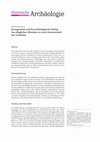
This paper discusses the role of things in the framework of the materiality of Nazi camps. It ana... more This paper discusses the role of things in the framework of the materiality of Nazi camps. It analyzes different dimensions of thing affordances and argues that the assumption of objects being used in ways of a "canonical affordance" risks to dangerously distort the cruel reality of the camps. Re-interpreting these assemblages also encounters a different problem, the "componentiality" of modern materiality. A consideration of different dimensions of thing affordances and their complex relation to componentiality ends in a style of interpretation that is close to Paul Ricoeur's "hermeneutics of suspicion". Zusammenfassung Dieser Artikel erörtert die Rolle der mobilen Gegenstände im materiellen Umfeld der Lager aus der Nazi-Zeit. Unterschiedliche Affordanzfelder der Dinge werden analysiert und die in Interpretationen oftmals vorherrschende Vorstellung der "kanonischen Affordanz" problematisiert, da diese unterschwellige Annahme zu einer deutlichen und ethisch unverantwortlichen Verzerrung der grausamen historischen Realität des Lagerlebens führen kann. Ein weiteres Problem neuzeitlicher Materialität ist ihre "Komponentialität", die auf komplexe Art mit unterschiedlichen Dimensionen der Ding-Affordanzen verschränkt ist. Das führt zu einem Vorgehen der Interpretation, welches in Anlehnung an Paul Ricoeur als "Hermeneutik des Verdachts" umschrieben werden kann. Moderne und Materialität "Zur Behandlung von Blutgeschwüren zog man den Schorf mit Papierbandagen aus dem Krankenbau ab und drückte den Eiter aus. Dann schüttelte man die kraterförmigen Fleischverluste mit Sägemehl aus der Fräsmaschine zu. Am besten waren wie Mehl aussehende, feingestoßene Sägespäne aus frischen Kiefernbrettern". Das berichtete Wlodimierz Borkowski über die Behandlung von Hautkrankheiten in Auschwitz (Jagoda u.a. 1994, 175). Ein anderes Beispiel zur Nutzung von Dingen: "Die Sache ist ganz einfach. Man macht einen Schlitz am Boden des Zementsacks, der aus vielen Schichten besteht, um den Kopf durchzustecken, und passende Schlitze an den Seiten für die Arme, und die Kleidung ist
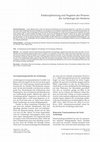
Unser Beitrag nimmt zuerst die historische Entwicklung der Archäologie allgemein in den Blick und... more Unser Beitrag nimmt zuerst die historische Entwicklung der Archäologie allgemein in den Blick und zeichnet kurz nach, dass Archäologie seit ihren Anfängen ein chronologisch und chorologisch expansives Feld ist. Eine Betrachtung dieser Geschichte macht deutlich, dass Archäologie kein ökonomisches Nullsummenspiel ist, in dem die Hinzufügung eines Aspektes auf Kosten eines anderen geht. In einem zweiten Teil zeigen wir auf, warum eine Archäologie der Moderne, obwohl sie nur einen chronologisch minimalen Teil menschlicher Geschichte dem Feld 'Archäologie' hinzufügt, tiefgreifende, bisher unzureichend gestellte Fragen aufwirft, die das gesamte von der Archäologie beackerte Feld betreffen. Es geht dabei nicht um kataloghaft aufgelistete Objektkategorien oder Befunde, sondern um Grundsatzfragen wie das Verhältnis zwischen Form und Inhalt archäologischer Diskurse sowie um die Bedeutung von 'Wissenschaftlichkeit'.
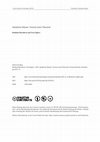
This paper introduces a series of case studies on the relation between subalternity and spatial c... more This paper introduces a series of case studies on the relation between subalternity and spatial configurations in archaeology and related fields. It discusses the origins of the notion of the subaltern and connects it to different conceptualizations of space and spatiality. Questions about the possibility for the subaltern to produce their own spaces are raised, as well as present possibilities and impossibilities for archaeologists and other social science researchers to identify and interpret such spatialities. Emphasis is placed on how various examples from both archaeology and cultural anthropology try to overcome the paradoxical nature of elaborating on people who remain largely if not entirely invisible to traditional procedures of academic research. Zusammenfassung Dieser Artikel präsentiert eine Reihe von Fallstudien, die sich dem Zusammenhang von Subalternität und räumlichen Konfigurationen in der Archäologie und in verwandten Gebieten widmen. Es wird der Ursprung des Begriffs des Subalternen diskutiert und mit unterschiedlichen Konzeptualisierungen von Raum und Räumlichkeit verbunden. Zum einen geht es um Fragen nach den Möglichkeiten der Subalternen, ihre eigenen Räume zu schaffen, und zum anderen um die Grenzen und Möglichkeiten der Archäolog*innen und anderer Sozialwissenschaftler*innen, solche Räumlichkeiten zu identifizieren und zu interpretieren. Der Schwerpunkt liegt dabei darauf, wie in den verschiedenen Beispielen aus Archäologie und Kulturanthropologie versucht wird, den paradoxen Charakter der Auseinandersetzung mit Personen zu überwinden, die für traditionelle Verfahren der akademischen Forschung weitgehend, wenn nicht gar vollständig, unsichtbar bleiben.
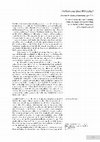
Brandenburgische Landesamt für Denkmalpflege und Archäologische Landesmuseum in Wünsdorf (BLDAM) ... more Brandenburgische Landesamt für Denkmalpflege und Archäologische Landesmuseum in Wünsdorf (BLDAM) zusammen mit dem Institut für ein ar ern ec Vorderasiatische Archäologie der Freien Universität Berlin eine Lehr-und Forschungsgrabung auf dem Areal der Moschee im Kriegsgefangenenla ger des Ersten Weltkriegs am Militärstandort Zossen. Unabhängig davon plante das Land Brandenburg schon länger die Einrichtung eines Erst aufnahmelagers für Asylsuchende auf einer Landesliegenschaft, die sich schon über 100 Jahre in öffentlicher Hand befindet. Groß war das Erstau nen auf beiden Seiten, als sich bei der Grabungsvorbereitung herausstellte, dass es sich um dieselbe Fläche handelt. Insofern war nun wegen der um fangreichen Bauplanungen im Bodendenkmal "Kriegsgefangenen-Lager und Moschee der Neuzeit" zusätzlich eine baubegleitende Dokumentation durch eine Fachfirma erforderlich. Das Lager war 1914 für muslimische Kriegsgefangene eingerichtetund deshalb im Volksmund"Halbmondlager" genannt-und 1918 wieder aufgegeben worden. Die Moschee wurde um 1930 abgerissen. In der Zeit des Nationalsozialismus wurde das Gelände mit zahlreichen Funktions bauten wie Panzerreparaturhallen und Kasernen bebaut. Die Lehr-und Forschungsgrabung hatte drei Ziele: Erstens sollte die Kulturerbe-Dimension des Orts in ihrer Komplexität durch eine praktische Auseinandersetzung mit diesem Erbe in Form einer Ausgrabung unter sucht werden; zweitens ging es darum, wie weit die Archäologie als eine für spezifische Gegebenheiten einer tiefen Vergangenheit entwickelte Disziplin in der Lage ist, mit neuzeitlichen Befunden umzugehen und was eventuelle Erkenntnisgewinne sein könnten; drittens hat der Ort des
In this paper, I briefly elaborate on the differences between two notions of third space, one roo... more In this paper, I briefly elaborate on the differences between two notions of third space, one rooted in postcolonial theory, the other in Marxist geography. Marxist geography is concerned with the production of antagonistic spatialities. I use this idea to analyze various notions of space of and in the Iranian Iron Age polity of the Medes. The main issue is the interpretation of "squatting" habitations at the two sites of Tepe Nush-i Jan and Godin Tepe. I argue that the flimsy walls set into the massive architecture of earlier levels are a sign of tensions over conflictual spatialities.
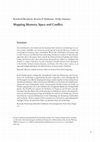
In der Einfuhrung des vorliegenden Sammelbands werden die Diskussionen uber Erinnerung in der Arc... more In der Einfuhrung des vorliegenden Sammelbands werden die Diskussionen uber Erinnerung in der Archaologie in gegenwartige Kontexte eingeordnet, unsere Beweggrunde fur die Herausgabe dieses Buches dargelegt und einige zentrale Aspekte von Erinnerung, Raum und Identitat diskutiert. Neben einem kurzen Uberblick zur Geschichte der Gedachtnisforschung mit einem Schwerpunkt auf den archaologischen Studien werden eine Reihe von Themen angesprochen, die in den Aufsatzen des vorliegenden Bandes eine wichtige Rolle spielen. Dies betrifft unter anderem das Verhaltnis von Vergessen und Erinnern sowie Beziehungen zwischen Raum, Ort und Erinnerung. In Einklang mit unseren AutorInnen betonen wir, dass Erinnerung eine Frage der Praktiken ist, nicht nur der Denkweise. Ein weiteres Element in unseren Diskussionen ist die Verbindung von Erinnerung, Fortbestehen und Geschichte. All diese Aspekte wirken zusammen bei einem diesen zugrundeliegenden wichtigen Thema der politischen Natur verschiedener Arten...
This essay consists of four different elements that approach the nexus of memory, place/space and... more This essay consists of four different elements that approach the nexus of memory, place/space and subjectivity in different ways. I start out with a description of the concept of lieux de mémoire as formulated by Pierre Nora, its connections to Marc Augé’s “non-places” and a critique of these ideas. I then discuss the postcolonial notion of Third Space as an alternative approach to the nexus of memory and space. Finally, an archaeological example of a megalithic site in Jordan illustrates the advantages and difficulties of mobilizing the idea of Third Spaces in archaeological contexts.
This introduction to a set of papers on innovations in ancient societies discusses an overview of... more This introduction to a set of papers on innovations in ancient societies discusses an overview of crucial issues raised in the collected contributions. It is evident that the esteem for innovations in different societies was highly uneven. Most of the contributions collected here argue that in non-modern circumstances, innovations had to be inserted into existing cultural traditions with utmost care to be successful.
eTopoi. Journal for Ancient Studies, 2016
Topoi research group B-4 Space – Identity – Locality focuses its research on the interconnections... more Topoi research group B-4 Space – Identity – Locality focuses its research on the interconnections between knowledge, space and identities. A multiplicity of sources – texts, images, architecture and objects – are analyzed both in their historical context and for their historiographic value. Following a brief description of the projects, key concepts of knowledge, space and identity are outlined as they relate to our specific research themes. We use ‘trialectics’ to emphasize that knowledge, space and identity constitute and influence each other. Concrete configurations of this constantly changing interplay of factors are illustrated by two case studies – the ritual compositions from Kizzuwatna (present southern Turkey) and the coin hoard of Krepost (present Bulgaria).
This paper analyzes ‘innovation’ as a discursive, narrative and dramatized construction with a st... more This paper analyzes ‘innovation’ as a discursive, narrative and dramatized construction with a strong tendency towards reification. I review examples, arguing for an understanding of innovation that moves away from new physical or epistemic things, to advocate instead a discourse-critical, practice-centered and contextualized understanding of innovations. Two cases from ancient Mesopotamia illustrate my argument. The first is found in every treatise on world historical changes: the introduction of writing. The second is a previously underappreciated and unperceived innovation for which there is even no clear expression: the emergence of a ‘documentary gaze’ . I elucidate its original context with pictorial evidence and describe the political dimensions surrounding this innovation.
uer seitrag entwickelt eine sestimmung des Zusammenhangs von Technik und Wissen im Rahmen der yab... more uer seitrag entwickelt eine sestimmung des Zusammenhangs von Technik und Wissen im Rahmen der yabermas’schen Theorie des kommunikativen yandelns, wobei der Unterschied zwischen praktischem und diskursivem Wissen im Mittelpunkt steht. rls znstrumentarium zur rnalyse historisch spezifischer wälle technischen yandelns st2tze ich mich auf die rnwendung von ,Operationsketten‘ und wende sie auf das Verzieren von sronzeund Kupferobjekten an. yierzu dienen zwei seispiele, das eine ethnoarchäologisch und aus der heutigen S2dost-T2rkei, das andere archäologisch und aus dem eisenzeitlichen Urartu in Ost-rnatolien. uie rnalyse ergibt in beiden wällen, dass praktisches Wissen in worm von rugenmaß im rblauf der Produktion eine wichtige Rolle spielt. Konsequenzen f2r die Strukturierung der technischen Kooperation werden erörtert.
In the summer of 2017, renewed fieldwork was undertaken at Tappeh Sofalin in the Varamin Plain. A... more In the summer of 2017, renewed fieldwork was undertaken at Tappeh Sofalin in the Varamin Plain. A total of 20 samples for absolute dating were collected during this season, several of which have been analyzed. We present this new evidence for the dating of the site and compare it briefly with published dates and analyses from other sites. Finally, we discuss implications for the chronology of the Proto-Elamite spread to the Central Plateau and other areas of Iran.
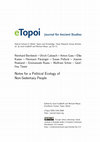
eTopoi. Journal for Ancient Studies, 2016
The research group Political Ecology of Non-Sedentary Communities encompasses three research proj... more The research group Political Ecology of Non-Sedentary Communities encompasses three research projects examining archaeological remains from various time periods in the Nile Delta, the foothills of the Kopet Dag and in the steppe region of western Eurasia; a fourth project in the group consists of climate and ecological modeling for Europe over the past 6000 years. The researchers in this group are investigating processes and dynamics which played out in different geographic spaces and different chronological periods between 9000 and 300 BCE. We propose a triad of three terms, Umgebung , Umwelt , and Mitwelt to serve as a conceptual basis for all of these projects, which vary greatly in terms of the chronological period, location and the way of life of the populations under study, as well as with respect to the archaeological database. The projects can be described on the basis of evidence of multifaceted practical actions. These actions on the part of the populations under study, re...
Size Matters - Understanding Monumentality Across Ancient Civilizations, 2019
Nothing is more obvious and at the same time hidden than the link between monumentality and labor... more Nothing is more obvious and at the same time hidden than the link between monumentality and labor. Bertolt Brecht's oft-cited poem is right on the mark when it comes to monumentality in the ancient Near East: "Who built Thebes of the seven gates? In the books you will read the names of kings. Did the kings haul up the lumps of rock? And Babylon, many times demolished, Who raised it up so many times?" (Brecht 2012: 13

Journal of Eastern Mediterranean Archaeology and Heritage Studies, 2017
This report describes archaeological rescue work in four looted tombs from late Roman and early B... more This report describes archaeological rescue work in four looted tombs from late Roman and early Byzantine times in the surroundings of Ramallah, located in the Occupied Palestinian National Territories (OPNT). One goal of our work was to assess in detail how much of the original remains of a tomb are left behind after looting. A second aim was to explore the actual practices of looting by comparing interviews with looters with the results of an archaeological examination of looting practices of these tombs. This provides a unique comparative perspective that draws on oral history and its material correlates. Finally, this work helps to assess future possibilities for reconstructing what has been lost during looting events. The results of the research include unexpected insights, such as the repetitive character of looting single tombs, the presence of modern material remains of the looting process itself, but also the use of previously looted tombs for new purposes.


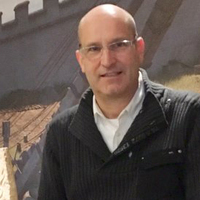


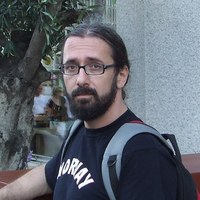
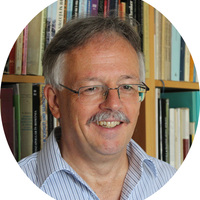

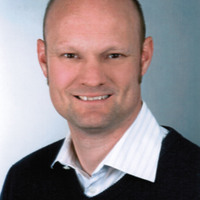

Uploads
Papers by Reinhard Bernbeck